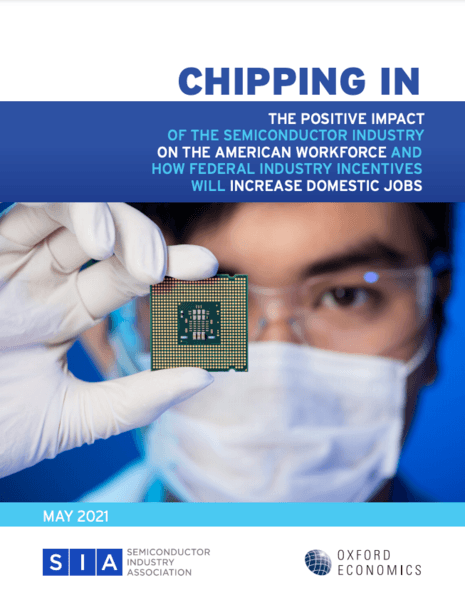Robust Federal Incentives for Domestic Chip Manufacturing Would Create an Average of Nearly 200,000 American Jobs Annually as Fabs are Built, Add Nearly $25 Billion Annually to U.S. Economy
Wednesday, May 19, 2021, 5:00am
by Semiconductor Industry Association
Semiconductor industry currently employs 277,000 people in the U.S. across 49 states, supports 1.6 million additional U.S. jobs, according to Oxford Economics/SIA study
WASHINGTON—May 19, 2021—The Semiconductor Industry Association (SIA), in partnership with Oxford Economics, today released a study analyzing the semiconductor workforce in the United States and the economic benefits that would come from robust federal investment in domestic chip production. The report, titled “Chipping In: The Positive Impact of the Semiconductor Industry on the American Workforce and How Federal Industry Incentives Will Increase Domestic Jobs,” finds the semiconductor industry directly employs more than 277,000 workers in high-paying R&D, design, and manufacturing jobs across 49 states and supports 1.6 million additional American jobs. The study also projects a $50 billion federal investment program to incentivize domestic semiconductor manufacturing would create an average of 185,000 temporary American jobs annually and add $24.6 billion annually to the U.S. economy as new semiconductor manufacturing facilities, or fabs, are constructed from 2021-2026.
 [DOWNLOAD THE SIA/OXFORD ECONOMICS STUDY]
[DOWNLOAD THE SIA/OXFORD ECONOMICS STUDY]
“American jobs are built on semiconductors, and workers in our industry are driving the innovations critical to America’s economy, national security, and global leadership in the technologies of today and tomorrow,” said Bob Bruggeworth, President, CEO, and Director of Qorvo and SIA Board Chair. “Leaders in Washington can spur greater U.S. economic growth and job creation, while also strengthening America’s chip supply chains, by investing boldly in domestic manufacturing incentives and research initiatives.”
In addition to boosting U.S. temporary job creation as fabs are built from 2021-2026, the study also finds a $50 billion federal investment program to incentivize domestic semiconductor manufacturing would add 280,000 permanent jobs to the U.S. economy beyond 2026, including 42,000 direct semiconductor industry jobs.
Other key report findings:
- The total impact of the semiconductor industry on the U.S. economy amounted to $246.4 billion in 2020.
- Semiconductors are a critical input for more than 300 downstream economic sectors, accounting for over 26 million U.S. workers.
- The semiconductor industry’s jobs multiplier is 6.7, meaning for each U.S. worker directly employed by the semiconductor industry, an additional 5.7 jobs are supported in the wider U.S. economy.
- Workers in the semiconductor industry are highly productive, and wages reflect this at $170,000 annual income, on average, in 2020.
- One in five workers in the industry has not attended college, meaning the industry provides important blue-collar opportunities, in which jobs exist for workers to gain skills and earn family-sustaining wages.
- The semiconductor industry employs a greater share of non-white workers when compared to the average of all industries in the U.S.
The study also highlights the urgent need to expand semiconductor R&D, design, and manufacturing in the U.S. through robust federal investments, such as those called for in the CHIPS for America (CHIPS) Act, federal legislation enacted in January 2021 but not yet funded. By supporting the expansion of the domestic semiconductor industry, nearly all other sectors of the economy will benefit, according to the study. This is accomplished either through supply chain spending and greater consumer spending or through the increased availability of semiconductors for downstream industries.
The share of global semiconductor manufacturing capacity in the U.S. has decreased from 37% in 1990 to 12% today, according to a September 2020 report by SIA and the Boston Consulting Group. That report also found that with a $50 billion federal investment in domestic semiconductor manufacturing incentives, there would be 19 major semiconductor manufacturing facilities, or fabs, built over the next decade, which is 10 more than would be built without such government investments.
Additionally, federal investment in semiconductor research has been flat as a share of GDP, while other governments have invested substantially in research initiatives to strengthen their own semiconductor capabilities. And global semiconductor supply chain vulnerabilities have emerged in recent years that must be addressed through government investments in chip manufacturing and research, according to a separate SIA-BCG study.
President Biden has called for $50 billion to fund the semiconductor manufacturing and research provisions in the CHIPS for America Act.
“Oxford Economics’ findings are a stark reminder of the tremendous catalytic effect of semiconductors on the U.S. economy and job creation, as well as the urgent need to strengthen domestic chip research, design, and manufacturing through robust federal investments,” said John Neuffer, SIA president and CEO. “We look forward to working with leaders in Congress and the administration to fund the CHIPS Act so more of the semiconductors America needs are researched, designed, and produced on U.S. soil.”
# # #
Media Contact
Dan Rosso
Semiconductor Industry Association
240-305-4738
drosso@semiconductors.org
About SIA
The Semiconductor Industry Association (SIA) is the voice of the semiconductor industry, one of America’s top export industries and a key driver of America’s economic strength, national security, and global competitiveness. Semiconductors – the tiny chips that enable modern technologies – power incredible products and services that have transformed our lives and our economy. The semiconductor industry directly employs over a quarter of a million workers in the United States, and U.S. semiconductor company sales totaled $208 billion in 2020. SIA represents 98 percent of the U.S. semiconductor industry by revenue and nearly two-thirds of non-U.S. chip firms. Through this coalition, SIA seeks to strengthen leadership of semiconductor manufacturing, design, and research by working with Congress, the Administration, and key industry stakeholders around the world to encourage policies that fuel innovation, propel business, and drive international competition. Learn more at www.semiconductors.org.
